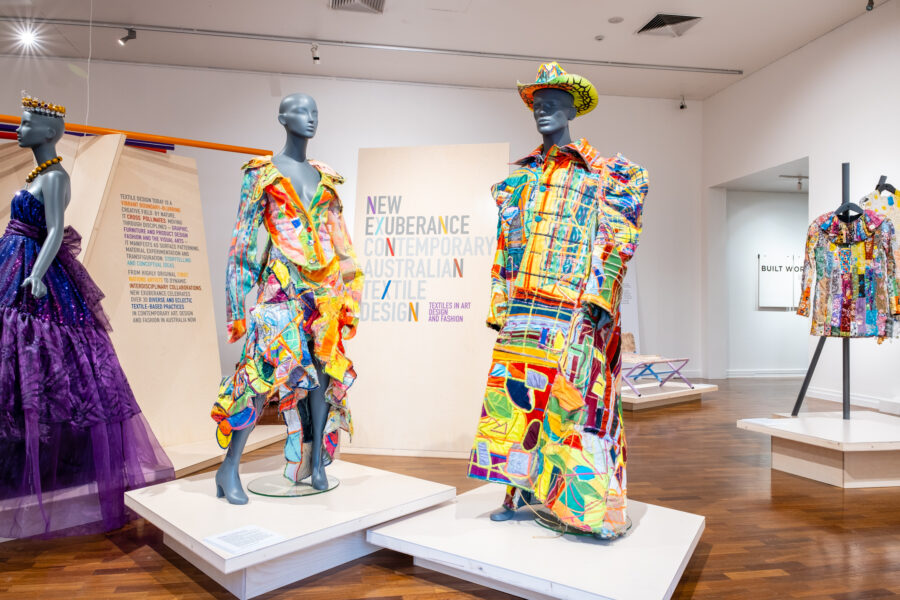Textile art encompassing artistic works made from fabric, thread, and yarn is experiencing a significant resurgence. Galleries and auction houses are reporting increased interest in tapestries, quilts, and textile installations. Across the United States, Canada, the UK, and the EU, major museums are dedicating exhibitions to textile art, while the art market itself increasingly recognizes textiles as equal to painting and sculpture.
This article examines how textile art is economically utilized across different sectors: fashion, tapestries, object-based art, brand collaborations, exhibitions, and digital formats.
Fashion: Where Art Meets Wearability
In the fashion industry, textile art plays a prominent role, especially through collaborations and haute couture. Luxury labels commission textile artists and weaving studios to create exclusive fabrics and embroidery. For example, Ralph Lauren launched its first “Artist in Residence” program in 2023 with Navajo textile artist Naiomi Glasses. The project resulted in limited collections featuring Jacquard coats and patterns rooted in Navajo tradition. According to Ralph Lauren himself, the goal was to present “the most authentic expression of heritage and craft” in collaboration with those who keep these traditions alive.
Naiomi Glasses noted that it was her dream to share traditional Navajo weaving with a global audience through fashion. Projects like this combine marketing momentum with cultural depth and appeal to a generation that values authenticity. Studies show that 81% of consumers prioritize authenticity in their purchase decisions, making artist collaborations highly desirable for brands.
Independent designers and labels also use textile art in their processes whether through hand-printed fabrics or collaborations with surface designers. Companies like H&M regularly launch limited collections with artist designs, while sportswear brands like Puma have featured artwork by Romero Britto on sneakers. These collaborations transform everyday fashion into wearable art and help position textile art within broader markets. Designers benefit from the story and value the art brings to their pieces.
Haute couture remains a niche market geared toward branding and exclusivity. Although figures are limited, the global fashion market, particularly in the luxury and online sectors, continues to show double-digit billion-dollar revenues, providing fertile ground for designer textiles.
Tapestries: Luxury, Collectibility, and Interior Statements
Tapestries are a classic form of textile art, now re emerging as luxury interior elements and collector items. In the US, UK, EU, and Canada, modern tapestries are seen not only as decor but also as cultural capital and investment pieces. These works are often handcrafted in small editions and sometimes sell for significant sums. A Le Corbusier tapestry from the 1950s, for example, fetched over 400,000 euros at auction in Paris in 2024 far exceeding the estimated value.
Contemporary tapestries are now experiencing what many call a market renaissance. Collectors view them as durable assets with artistic merit. On design platforms, limited editions of woven art range from $5,000 to $18,000, with demand coming from both private buyers and interior designers. Beyond their aesthetic appeal, tapestries are valued for the warmth and texture they bring to high-end architecture and luxury homes.
Object-Based Textile Art and Public Spaces
Textile art also thrives in the context of installation and public art. Cities and private developers are commissioning textile-based public artworks ranging from façade coverings to sculptural fiber installations in corporate lobbies. These projects often intersect with sustainability themes such as recycling and upcycling.
One notable example is Amanda Browder, who creates monumental fabric installations across US cities, funded through a combination of foundations and community sponsors. Similarly, music and cultural festivals increasingly integrate textile installations as visual landmarks. Textile object art thus merges craftsmanship with architectural imagination and offers businesses new ways to engage communities and audiences.
Brand Collaborations: Storytelling Meets Lifestyle
Beyond fashion, textile art finds its way into brand collaborations across lifestyle, luxury, and even tech sectors. Companies license textile motifs or commission new patterns for a wide range of products.
In the US, the Metropolitan Museum of Art licenses its textile collections to furniture and decor firms, enabling reproductions of historical designs in wallpapers and fabrics. Samsung collaborates with the Met to offer its digital art screens featuring curated images including textile motifs as customizable backgrounds.
In Europe, brands like IKEA partnered with the late Virgil Abloh to release limited-edition rugs and pillows. Sports brands and mass retailers also leverage the popularity of textile patterns for instance, Romero Britto’s bold art on Puma sneakers or Jean-Michel Basquiat’s designs in H&M’s collections.
These brand collaborations create mass-market access to textile art and help bridge fine art with daily life. From a business perspective, these partnerships reflect a trend toward products with emotional stories and cultural value.
Exhibitions and Museums: Monetizing Textile Art
Exhibitions and museum programming significantly contribute to the monetization of textile art. Ticket sales, exhibition catalogs, and museum shops generate direct revenue. In 2024, textile art gained prominence through major international exhibitions featuring artists like Sheila Hicks, Anni Albers, and Olga de Amaral. Visitor numbers at museums like the Stedelijk in Amsterdam surpassed 600,000, partly driven by these exhibitions.
Museums also capitalize on merchandising and licensing: textiles shown in exhibitions can become motifs for tote bags, apparel, or home decor sold in gift shops. The Metropolitan Museum, for instance, grants licenses for its artworks including textile-related pieces for use by fashion labels and design firms. Collaborations with brands like PacSun or Dr. Martens have brought historical textile patterns into mainstream retail, generating new revenue streams.
While exact financial data is often not disclosed, it’s clear that museums are increasingly using their collections and exhibitions as platforms for broader commercial strategies.
Digital Reproductions: NFTs, Online Stores, and Beyond
Digital platforms have become essential for distributing textile art. Artists sell digital prints, illustrations, or scans of their textile work via Etsy, independent stores, and art-focused e-commerce platforms. In 2023, online art sales accounted for 18% of the global art market, representing over $11 billion in revenue.
NFTs (non-fungible tokens) briefly opened up new possibilities for textile artists to sell unique digital representations of their designs. However, by 2024, NFT art sales had dropped by roughly 65% compared to the previous year, reflecting waning investor enthusiasm. Digital art’s share in the luxury segment fell from 15% in 2022 to just 3% in 2024.
Despite this decline, digital sales continue to matter. Artists offer downloadable design files, virtual catalogs, or augmented reality (AR) experiences to collectors and designers. Some use AI to generate textile patterns, merging traditional artistry with algorithmic design. The digital space thus offers scalable reach and diverse monetization methods essential for artists operating beyond physical exhibitions.
Textile art is gaining momentum as an economically viable discipline across various domains. In fashion, it contributes to exclusive branding and limited collections. In interior design, tapestries are increasingly considered high-end assets. Public and object-based textile art enriches urban spaces and provides new avenues for creative commissions. Collaborations with major brands extend the reach of textile patterns to millions, while museums generate income through merchandise and licensing. Although the NFT wave has receded, digital sales and licensing still offer meaningful revenue.
Altogether, these developments point to a broader trend: textile art is no longer a niche practice. Instead, it is being redefined as a valuable, contemporary form with deep cultural roots and compelling economic potential. From New York to Berlin, textile artists are weaving themselves into the fabric of the global creative economy.









